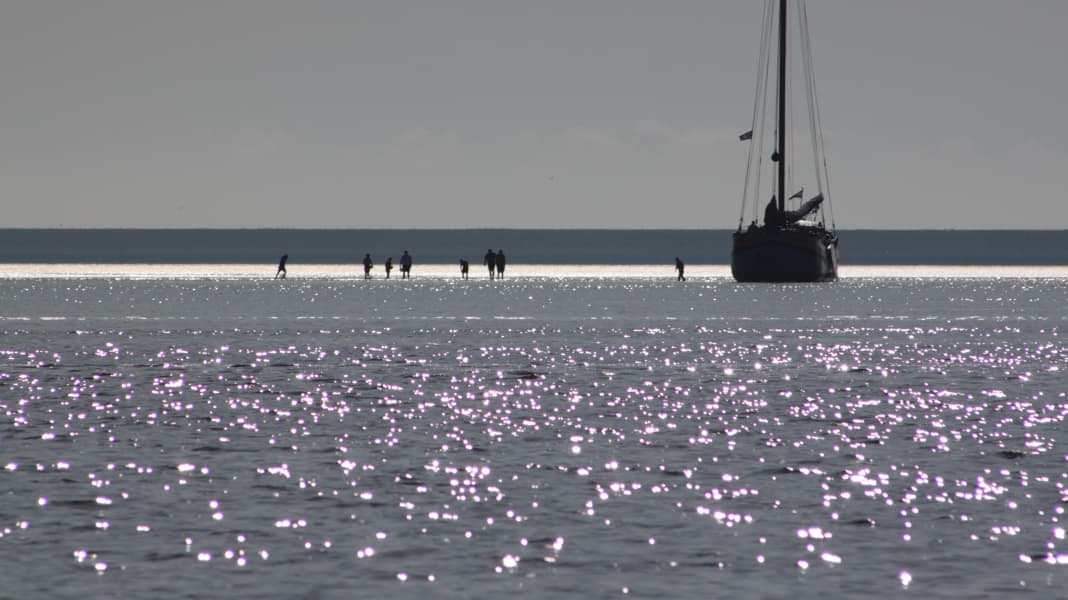
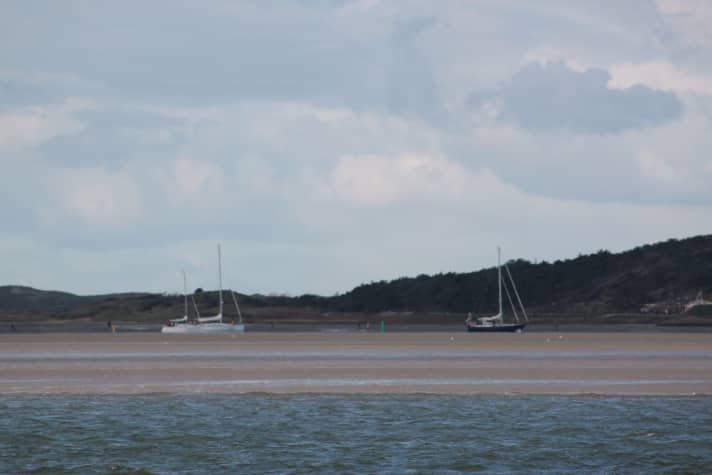
ARRIVAL
Charter ships to sail the mudflats are always moored on the IJsselmeer. This also applies to travelling to the mudflats: the region around the IJsselmeer is popular because it is easy to reach by car or train. Sailors from North Rhine-Westphalia and western Lower Saxony in particular, but also from Hesse and Rhineland-Palatinate, can be there in just a few hours. This is environmentally friendly and has the advantage that you can bring your provisions with you on the way, whereby the supermarkets in the Netherlands also offer attractive products such as Vla (vanilla pudding in a tetrapak), Stroopwaffels (caramel biscuits) or all kinds of food with an Indonesian background.
You should ask the charter station briefly where the car can be parked for the duration of the trip - this is usually possible on the marina grounds or in the surrounding area, usually free of charge. As in Germany, free parking is otherwise only possible in many places for a fee or for a short time. Prohibitions should be obeyed at all costs, the fines in Holland are significantly higher than in Germany. Incidentally, the same also applies to obeying the speed limit. Please note: From March 2020, the speed limit on motorways will be 100 km/h during the day (6 a.m. to 7 p.m.).
CHARTER
Here, too, the following applies: When it comes to charters, Watt actually means IJsselmeer. Exception: flat-bottomed ships with skipper and mate. These are often moored in Harlingen, the mini metropolis of the Wadden Sea. The "flat-bottomed boats" are popular because of their shallow and variable draught thanks to the side centreboards and the possibility of falling dry. There is a wide range of charter fleets, whether yacht or flat-bottomed. The charter hotspot for yachts is clearly Lemmer with several large bases. However, Lelystad, Stavoren, Workum and Enkhuizen also offer yachts of varying quality and therefore more or less favourable prices. Flat-bottomed boats are concentrated in the Workum, Gaastmeer and Heeg areas. The boats can be chartered with or without a skipper. Speciality in Workum: Sailcharter Friesland offers Lemsteraaken with furling foresails and mainsails with single-line gaff rig and lazybag. This may not be authentic, but it is extremely practical. It combines the variable draught of a flat bottom with the simple operation of a yacht.
The charter prices in Holland are favourable, in Europe they are only comparably low on the Baltic Sea. Very popular with customers, but not so popular with providers, is the option of chartering for a weekend or over public holidays only, which is much more common in the Netherlands than elsewhere, but is not offered by all charter companies. A boat with heating is highly recommended, as it can get quite cold even in summer. The heat source also helps if oilskins need to be dried. A dinghy is not necessary as you are always moored in harbours. Some companies offer gennakers; however, the large sail is more fun for experts.
If you would like to try out the mudflats in company, you can take part in one of the flotillas on offer. One of these is the YACHT skipper training Wattensee which takes place annually in September.
WIND & WEATHER
Just like the German coast, the Dutch Wadden Sea is known for its unpredictable summers, even if super summers like 2018 have become more frequent in recent years. From April to the beginning of September, winds from south-westerly to westerly directions dominate the scene. They blow on the mudflats in much the same way as directly on the coast, with an average of 12 to 16 knots or 3 to 4 Beaufort. Days with rain are always possible, with 13 to 20 days per month from April to October, the probability is high, but the rain never lasts long. It rarely rains for more than one day at a time. What's more, the perfect tourist infrastructure on land makes this an ideal time to visit - there's hardly a destination that doesn't offer a perfect alternative programme in bad weather. Unlike the IJsselmeer, the mudflats are still easy to navigate even in 6 Beaufort winds. The sandbanks make the waves less unpleasant as long as the tide is not running against the wind. Well reefed, the return journey from an island to the mainland can also be tackled when 6 Beaufort is blowing. If the wind and tide are against you and the fairway is too narrow to cross, engine power is required to ensure sufficient speed through the water at all times.
NAVIGATION & SEAFARING
The Wadden Sea is quite challenging to navigate. The fairways are well buoyed, but the current and the changing water level require careful planning when navigating the mudflats with keel yachts; nobody wants to experience a tide lying on its side. Otherwise, the basic principle is that you should sail to the island when the tide is out and back when it is in. There is a lot of literature on sailing on tidal waters. One very comprehensive work is " Sailing in tidal waters" by Wilfried Krusekopf.
There are five inhabited islands in the Dutch Wadden Sea. From west to east, these are Texel, Vlieland, Terschelling, Ameland and Schiermonnikoog. The first three are always accessible from the mainland. Ameland and Schiermonnikoog can only be reached via shallow harbours. The harbour of the easternmost island is even largely dry, and there is often less than a metre of water in the rest of the basin. Here it is highly recommended to contact the harbour master and clarify whether the island can be reached at all with the draught of the charter boat.
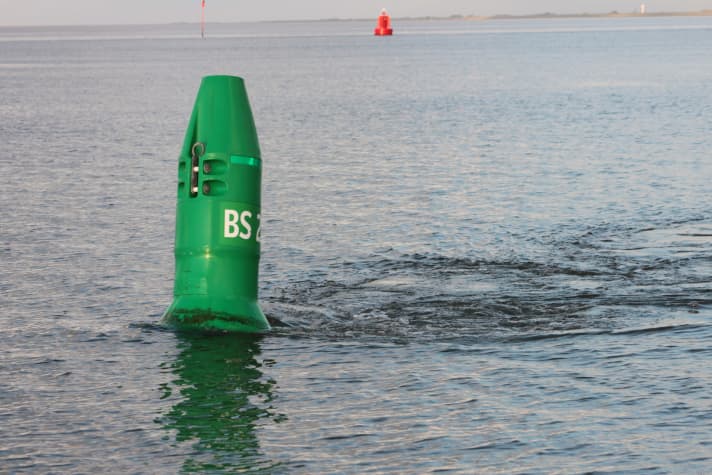
Bridges and locks: They are actually just locks, the Wadden simply doesn't have any bridges. The locks in Den Helder, Den Oever, Kornwerderzand, Harlingen and Lauwersoog are operated normally. When locking out on salt water, it is essential to pay attention to the current into the lock chamber and to tie the stern line first. Otherwise the locks are not critical, although it can get very crowded in Den Oever and Kornwerderzand in the high season. Patience is then required.
The Tsjerk Hiddessluizen in Harlingen offers a special feature: It is sometimes "spit" through at low tide. The lock is simply opened and large quantities of water flow from Friesland into the mudflats. The lock is then passable, but there are several knots of current in the chamber. You might prefer not to go through. The "Spuien" can be recognised by three red lamps in a triangle.
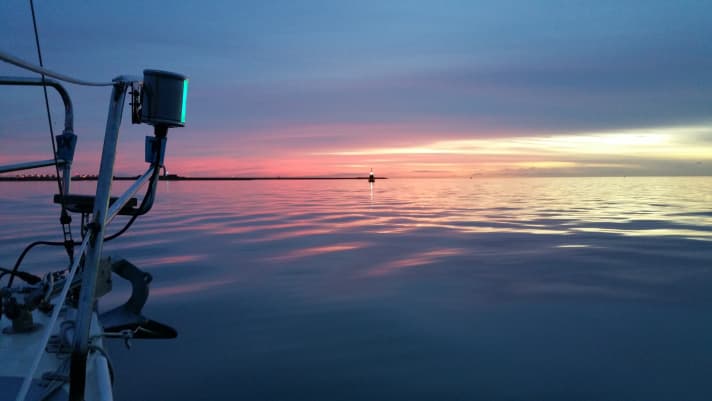
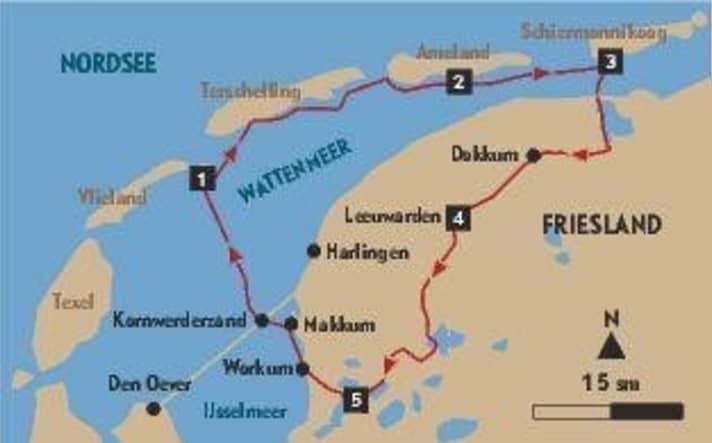
HARBOURS & ANCHORAGES
The harbours on the islands in particular are well equipped and prepared for guests. In Oudeschild on Texel you can moor in boxes with short side pontoons, on Vlieland there is the option of mooring alongside or in boxes, Terschelling offers alongside berths. The same applies to Ameland and Schiermonnikoog. The harbours are often full in summer, some are simply closed when they are full, Vlieland in particular is known for this. You then have to anchor outside the harbour and wait until the harbour master calls you in. Or you can plan your trip in advance using the website of the www.waddenhavens.nl. Webcams can also be used to see what is going on in the harbour. Anchoring, if at all, only takes place off Terschelling and Vlieland or in suitable channels. Caution: When anchoring, calculate the height of the tide and determine the shallowest water depth. Is this sufficient? It is also important to bear in mind that the current will capsize and the anchor will then have to hold in the opposite direction.
On the mainland, there are harbours in Den Helder, where the Royal Navy harbour on the starboard side next to the entrance is particularly recommended, in Den Oever outside the lock, in Harlingen in the Noorderhaven and Zuiderhaven and in Lauwersoog. What they all have in common is that the water level is logically changeable and floating jetties are not always available (Noorderhaven Harlingen on starboard). Then you have to look after the lines, even at night. It is also possible to moor for the night at the Kornwerderzand and Den Oever locks after asking the lock keepers. If you only have a shallow draught (less than 1.60 metres) and like it quiet, you can turn sharp right immediately after the Tsjerk Hiddessluizen and sail into the Harlinger Binnenhafen.
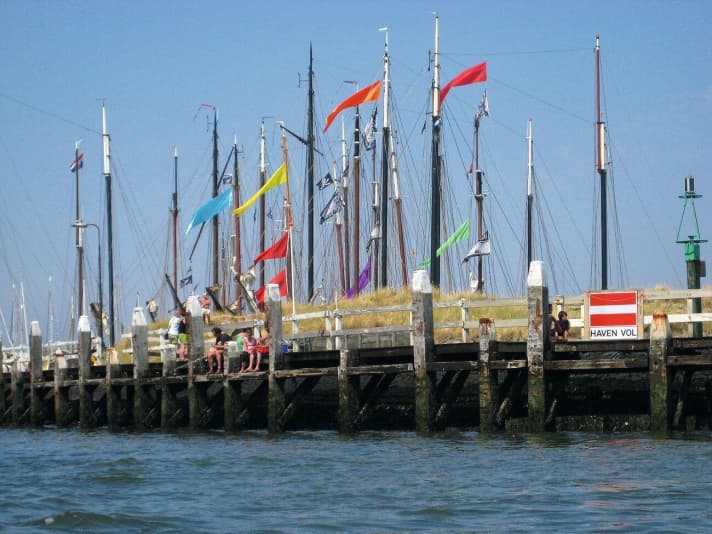
It is generally advisable to follow the harbour master's instructions and the length boards on the jetties. On the islands, packet mooring is the rule rather than the exception. If you don't like it, you should stay away from the islands.
LITERATURE & NAUTICAL CHARTS
The ANWB's Wateralmanak is an indispensable reference work for every cruise. The two-volume work lists all telephone numbers, VHF channels and opening times of bridges and locks, among other things; it also contains all harbour information. Each volume costs 19.95 euros and is available from specialised dealers. Nautical charts: The ANWB charts, sets 1811 and 1812 Waddenzee West and Oost, are the most frequently used. The charts from NV-Verlag, set NL 3, 49.00 euros, are also good. Nautical information is available at www.vaarweginformatie.nl. General information on fairways, dates, activities, country and people can be found on www.stegfunk.de a portal for water sports enthusiasts in the Netherlands.
The HP 33 atlas, which shows tidal heights and currents, is very useful for tidal navigation. Information on tides can be found on the website waterinfo.rws.nl. A lot of information about the Wadden Sea can also be found on the website nautin.nl.
REVIER-CHARAKTERISTIK Wadden Sea
The Wadden Sea is officially considered an inland area, but the tides and weather make for a real seafaring feeling. And it smells of salt water. Sea fog is notorious, especially in the early season. Then navigation becomes difficult. It becomes just as difficult when the wind and current come from ahead. The speed over ground then drops rapidly. This must be planned for, but sometimes it can hardly be avoided. Incidentally, it is best to have the current on your side, but this is not always possible. Many tips for sailing on the mudflats can be found here.
Sailing on the mudflats is only really dangerous in the sea channels. Especially when northerly winds are blowing and the water runs off the mudflats. This is when so-called bottom seas form, which can be quite dangerous for yachts. The Molengat to the west of Texel and the Seegatt between Schiermonnikoog and Ameland are particularly well known for such situations.
However, if you take a trip on the mudflats with the current and a suitable wind into the sunrise or sunset, holding a coffee or tea in your hand, you will quickly realise how wonderful it can be here. Maybe you'll even see a harbour seal or a porpoise. What's more, a successful trip across the mudflats leaves the skipper feeling particularly satisfied, as the challenge was a little greater than on the IJsselmeer, for example, due to the current.
A typical tour with a keel yacht could look like this:
Day 1: Lemmer to Den Oever, approx. 25 nautical miles
Day 2: Den Oever to Oudeschild, approx. 11 nautical miles
Day 3: Oudeschild to Vlieland via the Paardehoek, approx. 32 nautical miles
Day 4: Vlieland to Terschelling, approx. 10 nautical miles
Day 5: Terschelling to Harlingen, approx. 16 nautical miles
Day 6: Harlingen to Lemmer, approx. 40 nautical miles
Then you have travelled to all the important destinations without getting really stressed. Depending on the tide, the tour can also be completed without extreme times. Apart from the stage from Oudeschild to Vlieland, all sections can be travelled at any time, but the tide may be running against you. This means that a 5-knot speed through the water can sometimes only be 2.5 knots over ground, which means it takes longer. On the leg away from Texel, the route is flat, provided you take the shortcut via the Scheurak/Inschot/Paardenhoek. You should arrive at Kornwerderzand about 1 hour before high tide, then you will be fine with a draught of two metres (assuming the chart depth remains the same!).
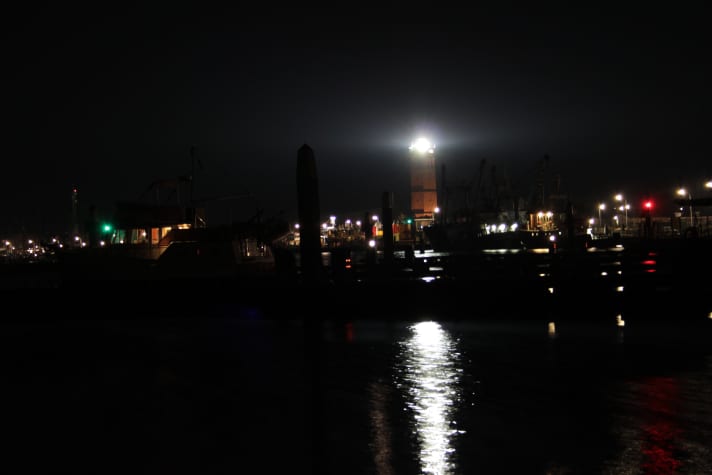
It is advisable to navigate very carefully on the mudflats. The current can quickly carry you out of the fairway or buoys can be confused, and it is usually equally shallow next to the fairway. Exception: In some places there are yellow buoys outside the fairway, showing a two-metre depth line. The area between the fairway and these yellow buoys should be used explicitly by recreational skippers, also to give the sometimes very fast ferries enough space.
A special feature of the Wadden Sea is the so-called brown fleet, so called because it used to have dark (brown) sails. These are old cargo ships that have been converted into passenger ships. The captains on the ships are usually a little idiosyncratic. They are considered commercial vessels and therefore enjoy right of way on the inland waterways, which they are happy to take. It is therefore advisable to keep your distance.
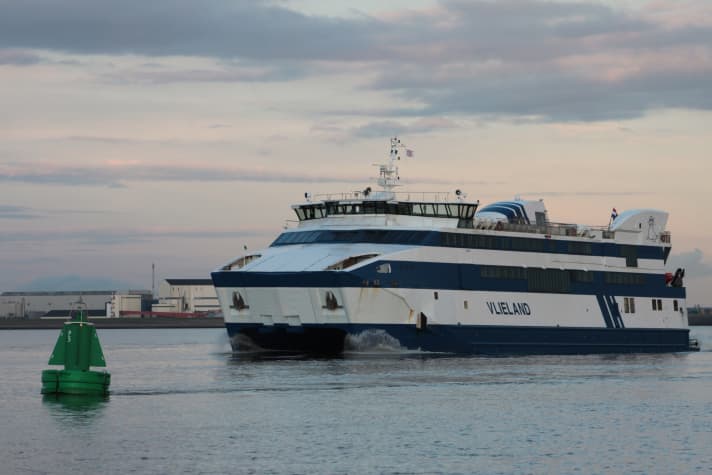
The islands themselves are all different. Texel is a family island with huge beaches and the seal centre Ecomare Vlieland is a very small island that is almost reminiscent of the Ile de Porquerolles in the south of France in summer: pine forests, beach, no cars, a small town and peace and quiet. Incidentally, the beach practically starts at the marina. Oh yes: no cars is not quite true. The legendary Vliehors Express.
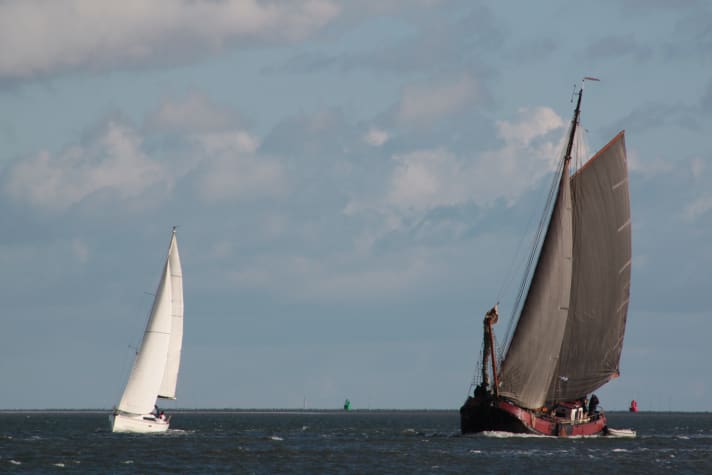
Terschelling, on the other hand, is a livelier island: many restaurants and pubs, several villages and, of course, the beach. One of the most beautiful spots is the " Paviljoen de Walvis " in West-Terschelling. Sitting there with a cold drink, you can watch and comment on the shipping traffic in and out of the harbour. Terschelling gets particularly busy at Oerol Festival. Every June, the island is transformed into a colourful, shrill and extravagant cabaret stage. You should have seen it.
Ameland is also a family island and Schiermonnikoog is very quiet.
On the mainland, Lauwersoog awaits guests with its fish stalls, but there is not much else going on here. On the way back towards Lemmer, if you're doing the big Wadden round, it's better to cycle straight through to Dokkum. Harlingen is the next town on the mainland. A stop here is also worthwhile. Den Oever and Den Helder don't have too much to offer, although the lifeboat and naval museums in Den Helder are well worth a visit. But one thing is clear: the highlights of the area are the islands. And they really are worth a visit at any time of year!

